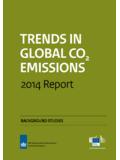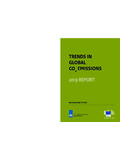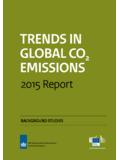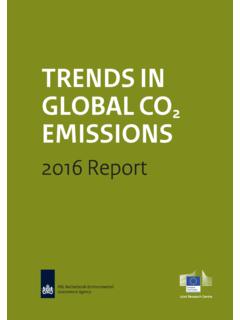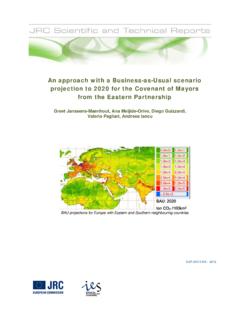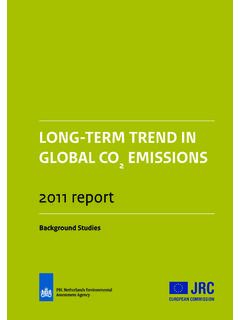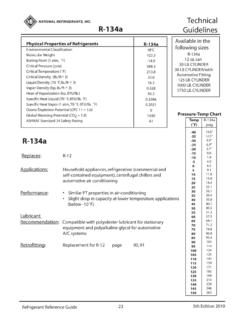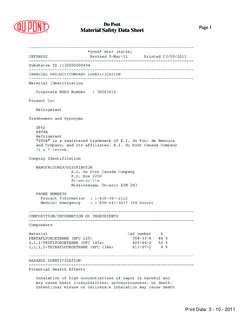Transcription of PART III: GREENHOUSE-GAS EMISSIONS - Europa
1 CO2 EMISSIONS FROM FUEL COMBUSTION (2012 Edition) - part III: GREENHOUSE-GAS . EMISSIONS . INTERNATIONAL ENERGY AGENCY. CO2 EMISSIONS FROM FUEL COMBUSTION (2012 Edition) - 1. SHARES AND TRENDS IN GHG. EMISSIONS . When considering comparative shares and trends in The information in part III (with the exception GHG EMISSIONS , data on gases and sources other than of CO2 EMISSIONS from fuel combustion) has CO2 from fuel combustion are much more uncertain. been provided by Jos Olivier from the PBL Country-specific estimates of CO2 from biomass Netherlands Environmental Assessment Agency burning and F-gas EMISSIONS are particularly difficult to and Greet Janssens-Maenhout leading the ascertain. EDGAR team of the Joint Research Centre (JRC) of the European Commission, using the EDGAR FT2010 database developed jointly by JRC and PBL.
2 Shares by gas Country data have been provided for 1990, 2000, 2005 and 2010. Moving from the EDGAR to the EDGAR FT2010 database has resulted in The contribution of non-CO2 gases to total EMISSIONS a few revisions to GREENHOUSE-GAS (GHG) can be estimated by expressing the EMISSIONS of all estimates for some source categories for years the gases in CO2-equivalent units. For a given gas, before 2010. However, in most cases these EMISSIONS expressed in mass are multiplied by its spe- changes led to very small changes in the global cific weighting factor, the Global Warming Potential total. Please see Chapter 2 for further details on (GWP). The GWP is an estimate of the relative con- data sources and methodology. tribution of a kilogramme of that gas to global radia- tive forcing, as compared to the same amount of CO2, Emission trends for gases and sources are pro- vided in this discussion through 2010.
3 Integrated over a fixed period of time ( 100 years). The UN Framework Convention on Climate Change (UNFCCC), following the Second Assessment CO2 EMISSIONS from fuel combustion constitute the Report of the Intergovernmental Panel on Climate majority of anthropogenic GHG EMISSIONS . However, Change (IPCC), uses the 100-year GWPs of 21 for comprehensive analysis of EMISSIONS and emission CH4, 310 for N2O and 23 900 for SF6. For the most trends considers other sources of CO2 as well as other common HFCs, GWPs vary between 140 and 3 000. gases. (1 300 for HFC-134a). For the by-product HFC-23, To complement work regarding the EMISSIONS of CO2 the GWP is 11 700. The GWPs for PFCs vary be- from fuel combustion, the IEA elected to include the tween 6 500 (CF4) to 9 200 (C2F6). These two PFCs, EDGAR data on other CO2 sources and on five other the ones most commonly used, are also significant greenhouse gases; CH4, N2O and the fluorinated gases sources of by-product EMISSIONS .
4 This chapter ex- (or F-gases ) HFCs, PFCs and SF6. These gases are presses all emission data in CO2-equivalents using addressed by the Kyoto Protocol. these GWP values. INTERNATIONAL ENERGY AGENCY. - CO2 EMISSIONS FROM FUEL COMBUSTION (2012 Edition). In 2010, CO2 contributed 76% of global GHG For nitrous oxide (N2O), agriculture contributed EMISSIONS , CH4 about 16%, N2O about 6% and the 70% of EMISSIONS in 2010, mainly from synthetic combined F-gases about 2% (Figure 1). The largest fertilisers and animal waste dropped on soils (either as sources of GHG EMISSIONS were the energy sector animal manure or by animals during grazing) and (68%, mainly CO2 fossil fuel use), and agriculture agricultural waste burning (Figure 3). A much smaller (11%, mainly CH4 and N2O). Other sources of green- source is fuel combustion (9%, mainly from coal, house gases were CO2 from biomass burning (10%, mostly forest and peat fires and post-burn decay in fuelwood and road transport).)
5 Another small source non-Annex I countries), and CO2 from cement is N2O from industrial processes (4%), mostly in production (3%, of which 54% originated in China). Annex I countries. Please note that EMISSIONS from forest and peat fires are highly variable over the years. Figure 1. Global GHG EMISSIONS Figure 3. Global N2O EMISSIONS by gas/source in 2010 in 2010. N2O- N2O-Other F-gas-All Energy Agriculture 2% 2% Other 9%. 17%. CH4-Other 4%. 3%. CH4- Agriculture Industrial 7% Processes 4%. CH4-Energy 6%. CO2-Fossil CO2-Other fuel use 15% 61%. Agriculture 70%. As seen in Figure 2, on an individual gas basis, the For the fluorinated gases (Figure 4), EMISSIONS are major global sources for methane (CH4) in 2010 were: split between use and by-products because of the agriculture (43%), mainly from enteric fermentation different ways they are produced.
6 HFC use repre- by animals and animal waste, from rice cultivation sented 55% of the total in 2010, of which HFC 134a and from savannah burning; alone represented 42%. Total by-product EMISSIONS of energy production and transmission (38%), mainly HFC contributed 21% and by-product EMISSIONS of from coal production, and gas production and PFCs another 5%. SF6 use represented 17%, while transmission; PFC use represented the remaining 2%. Most F-gas waste (17%), from landfills and wastewater. EMISSIONS are emitted by Annex I countries. Figure 2. Global CH4 EMISSIONS in 2010 Figure 4. Global F-gas EMISSIONS in 2010. Other 2% SF6 use Waste HFC- by- 17% product 17%. 21%. PFC use Energy 2%. 38%. PFC by- product 5%. Agriculture 43%. HFC use 55%. INTERNATIONAL ENERGY AGENCY. CO2 EMISSIONS FROM FUEL COMBUSTION (2012 Edition) - The shares of Annex I countries in total CH4 and total Shares by region N2O EMISSIONS (26% and 27% respectively) were relatively low compared to their share in global CO2.
7 EMISSIONS (38%). In 2010, most methane EMISSIONS originated in non- Annex I regions such as Asia (42%) including China In 2010, most fluorinated gas EMISSIONS originated in (21%) and Latin America1 (12%). EMISSIONS from Annex I countries (66%), with North America Annex I countries contributed 26% of total emis- contributing 38%, OECD Europe 13%, OECD Asia sions, with the largest contribution coming from the Oceania 9% and Other Europe and Eurasia 7%. Non- Annex I members of the Former Soviet Union (8%) Annex I countries contributed about 34% to global and North America (8%). F-gas EMISSIONS . For methane, EMISSIONS from animals and their waste dominate sources in Latin America and South Asia, Total GHG emission trends while EMISSIONS from rice cultivation are common in South, East and Southeast Asia. Coal production EMISSIONS related to fossil fuels dominate the global EMISSIONS are concentrated in East Asia (mainly trend in total GHG EMISSIONS .)
8 Between 1970 and China), North America, and Other Europe and 2010, total global anthropogenic GHG EMISSIONS Eurasia, while EMISSIONS from gas systems are con- increased considerably, with increases of CO2 (includ- centrated in the Former Soviet Union countries and ing large-scale biomass burning of forests and North America. Methane from landfills stems mainly biomass decay) by about 107% and increases of CH4. from Annex I countries, whereas methane EMISSIONS and N2O by about 47% and 43%, respectively, and the from wastewater disposal originate predominantly in F-gases by about 700%. Total EMISSIONS of all green- non-Annex I countries. house gases - weighted by their GWP - increased by Non-Annex I regions produced three-quarters of about 80% since 1970. global nitrous oxide EMISSIONS in 2010: Asia (36%) According to the EDGAR FT 2010 dataset, global including China (18%), Africa (19%) and Latin total GHG EMISSIONS increased by 31% during the America (14%).
9 N2O EMISSIONS from Annex I period 1990-2010 (Figure 5). A 44% growth in CO2. countries contributed 27% to the global total, with EMISSIONS from fuel combustion drove much of this most EMISSIONS originating in North America (11%) increase. Over the same period, although highly vari- and OECD Europe (9%). able over time, CO2 EMISSIONS from biomass burning and post-burn decay based on satellite observations Of all nitrous oxide sources, animal waste EMISSIONS are assumed to have decreased by about 10% with occur predominantly in the non-Annex I regions of CO2 from decay of drained peatland increasing by Latin America, Africa and South Asia; N2O from 18% since 1990. Increases in CO2 EMISSIONS from fertiliser use is largest in East Asia (mainly China) cement production (120%), CH4 EMISSIONS from fossil and Latin America followed by North America, fuel production (44%) and waste (21%), N2O.
10 Annex II Europe and South Asia (mainly India). N2O EMISSIONS from agriculture (20%) and the F-gases EMISSIONS from crop production are largest in North (about 225%, mainly from HFC use) also contributed America, Latin America, South Asia and East Asia. to the total increase. The F-gases (for which 1995. Industrial processes also emit significant volumes of generally serves as base year) increased their share of N2O. global EMISSIONS from in 1990 to in 2010. 1. For the purposes of this discussion, Latin America refers to non- OECD Americas, Chile and Mexico. North America refers to Canada and the United States. Former Soviet Union contains both Annex I and non-Annex I countries. INTERNATIONAL ENERGY AGENCY. - CO2 EMISSIONS FROM FUEL COMBUSTION (2012 Edition). Figure 5. Trend in global GHG EMISSIONS 1970-2010. GtCO2-eq.
